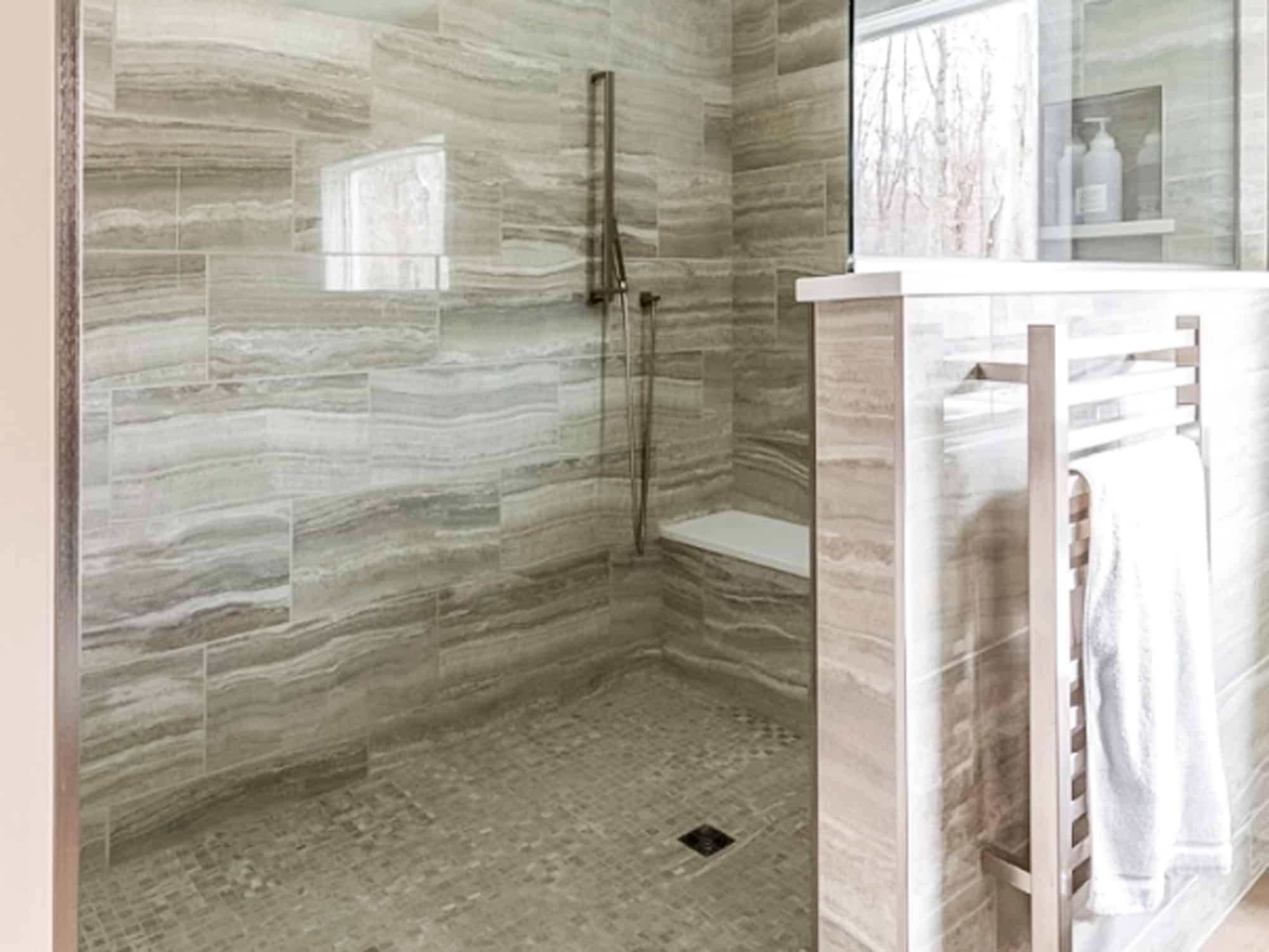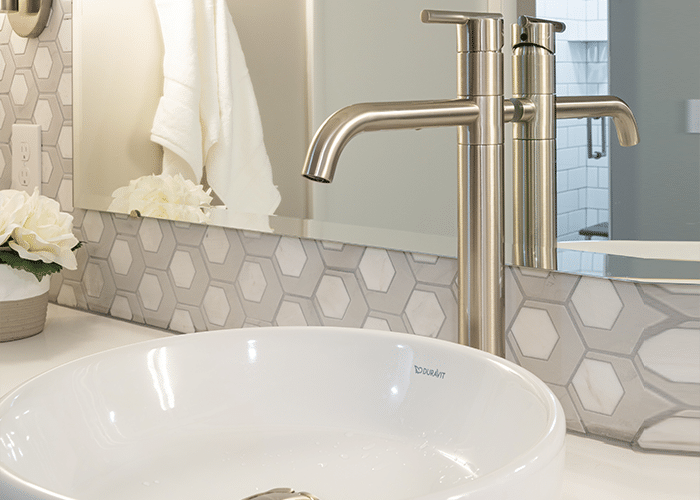Applying aging in place bathroom design to your bathroom remodel is very beneficial. Doing so makes your bathroom easier to use now and in the future. Thinking about the future now also saves you money. But how much does aging in place bathroom design affect the overall cost of your project? Because the design team at Capozzi holds Certified Aging in Place Specialist credentials, we can guide you through the expenses associated with creating a bathroom that is functional, comfortable, and accessible for all stages of life. Please keep reading to learn about key aging in place features, their price points, and other costs of aging in place bathroom design.
Costs for Aging in Place Bathroom Design Elements
Walk-In Showers
Walk-in showers are a popular choice for aging-in-place remodels due to their accessibility. Unlike traditional bathtubs or showers with high thresholds, walk-in showers feature low or zero-entry designs, making them easier to use and safer for individuals with mobility issues. However, installing a walk-in shower can add between $4,000-$15,000 to your bathroom remodel’s cost. The price varies based on your bathroom’s size, design complexity, and materials.

Grab Bars
Grab bars are essential for enhancing safety in the bathroom. They provide support and stability, reducing the risk of falls. Grab bars typically cost $100-$200 each, including installation. While these dollar amounts may seem modest, the total expense can increase depending on the number and placement of grab bars throughout the bathroom.
Bidet Toilets
Many people find bidet toilets more comfortable and hygienic than regular toilets. Depending on the model and features, bidet toilets range in price from $500-$2,000. While the initial investment might seem high, bidet toilets help aging homeowners maintain their health and independence. Therefore, bidet toilets are a valuable addition to your aging-in-place bathroom remodel.
Additional Heating Options
Aging homeowners also find using the bathroom more pleasant with heated items. Capozzi can install heated floors, towel racks, mirrors, and more during your bathroom remodel. The options for heated elements vary greatly, as do their prices. And the total cost of your bathroom remodel will fluctuate based on exactly which heated items you want and which versions you choose. So, Capozzi will offer professional recommendations that are condition-dependent.

Non-Slip Flooring
Non-slip flooring is textured to increase friction beneath your feet. So, this type of flooring works to minimize slips, falls, and accidents in the bathroom. Non-slip flooring is an essential aging in place bathroom design component. But it can substantially impact your overall budget, especially for larger bathrooms.
Wider Doorways and Space
Bathrooms must maintain specific dimensions in and around the doorway, shower, toilet, and sink to be accessible. For example, the minimum width of an accessible bathroom doorway is 32 inches with the door open. Navigating your bathroom will be much simpler later in life if your bathroom remodel follows aging in place bathroom design now.
However, modifying doorways and opening the space for accessibility can significantly raise your remodel’s overall cost. Widening doorways or reconfiguring the layout might involve structural changes that can add several thousand dollars to the project’s price.
Easy-to-Reach Controls and Fixtures
Lever-style handles and touchless faucets help older people get in and out of the bathroom without much trouble. But again, adjusting the height and type of controls and fixtures adds to the remodel’s cost. While these features improve accessibility, their installation and the potential need for additional plumbing or electrical work can increase the project budget.

How Aging-in-Place Bathroom Design Affects Overall Costs
Incorporating aging-in-place features into your bathroom remodel can lead to a higher overall cost. These features often require specialized materials, additional labor, and potential structural changes that affect your project’s bottom line. Here’s how these elements can influence your budget:
- Design Complexity: Aging-in-place features often require custom designs and installations. Walk-in showers, for instance, may involve reconfiguring plumbing and drainage systems, which can increase labor and material costs.
- Material Choices: Aging in place bathroom design elements usually use high-quality, durable materials to ensure long-term functionality. For example, we recommend non-slip flooring and grab bars for their safety and endurance, but they can be more expensive than standard options.
- Labor Costs: Installing specialized features like heated floors or bidet toilets can require extra expertise. Skilled labor costs more, which your project’s budget will reflect.
- Structural Modifications: Making your bathroom accessible may involve structural changes, such as widening doorways or adjusting the layout. These modifications can significantly increase the cost of the project.
Understanding the Value of Aging-in-Place Bathroom Design
While aging in place bathroom design may lead to a higher initial cost for your bathroom remodel, it secures lasting advantages. Investing in these features lets you enjoy a safer, more accessible, and more convenient bathroom for years. These modifications can also reduce the need for future renovations and boost the resale value of your home.
At Capozzi Design Build, we specialize in designing and remodeling bathrooms with aging-in-place considerations. Our team includes Aging in Place Certified Designers with CAPS (Certified Aging-in-Place Specialist) and CLIPP (Certified Living In Place Professional) certifications. We can help you navigate the costs and benefits of these features, ensuring that your bathroom meets your current and future needs. Contact us today to learn how we can provide the perfect bathroom remodel.


